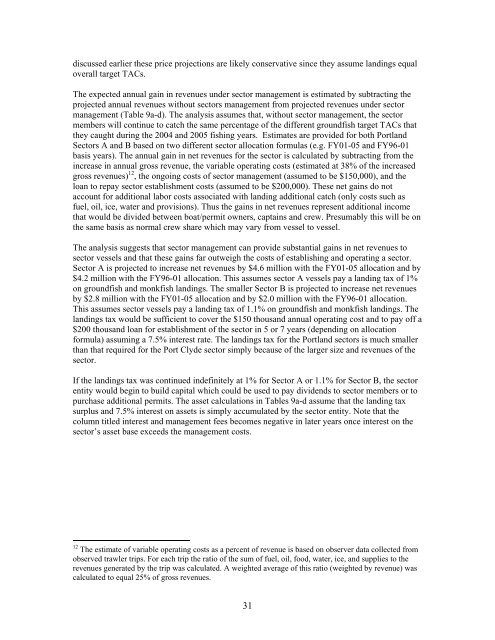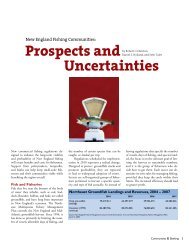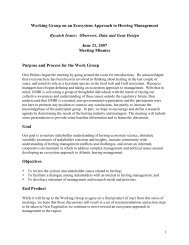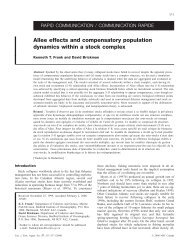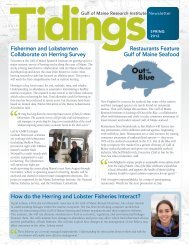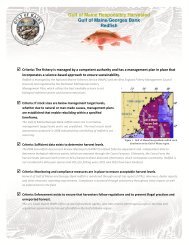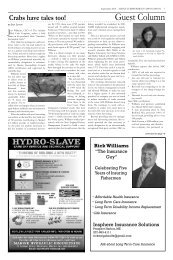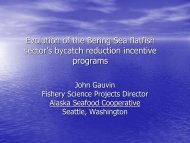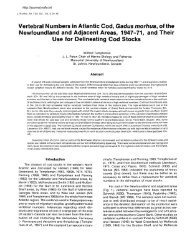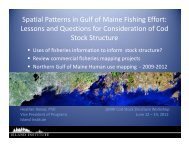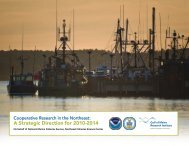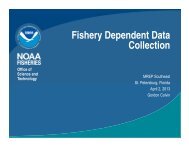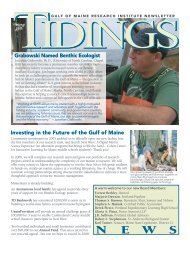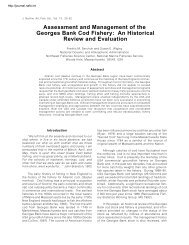Community-based Sectors for the New England Groundfish Fishery
Community-based Sectors for the New England Groundfish Fishery
Community-based Sectors for the New England Groundfish Fishery
You also want an ePaper? Increase the reach of your titles
YUMPU automatically turns print PDFs into web optimized ePapers that Google loves.
discussed earlier <strong>the</strong>se price projections are likely conservative since <strong>the</strong>y assume landings equal<br />
overall target TACs.<br />
The expected annual gain in revenues under sector management is estimated by subtracting <strong>the</strong><br />
projected annual revenues without sectors management from projected revenues under sector<br />
management (Table 9a-d). The analysis assumes that, without sector management, <strong>the</strong> sector<br />
members will continue to catch <strong>the</strong> same percentage of <strong>the</strong> different groundfish target TACs that<br />
<strong>the</strong>y caught during <strong>the</strong> 2004 and 2005 fishing years. Estimates are provided <strong>for</strong> both Portland<br />
<strong>Sectors</strong> A and B <strong>based</strong> on two different sector allocation <strong>for</strong>mulas (e.g. FY01-05 and FY96-01<br />
basis years). The annual gain in net revenues <strong>for</strong> <strong>the</strong> sector is calculated by subtracting from <strong>the</strong><br />
increase in annual gross revenue, <strong>the</strong> variable operating costs (estimated at 38% of <strong>the</strong> increased<br />
gross revenues) 12 , <strong>the</strong> ongoing costs of sector management (assumed to be $150,000), and <strong>the</strong><br />
loan to repay sector establishment costs (assumed to be $200,000). These net gains do not<br />
account <strong>for</strong> additional labor costs associated with landing additional catch (only costs such as<br />
fuel, oil, ice, water and provisions). Thus <strong>the</strong> gains in net revenues represent additional income<br />
that would be divided between boat/permit owners, captains and crew. Presumably this will be on<br />
<strong>the</strong> same basis as normal crew share which may vary from vessel to vessel.<br />
The analysis suggests that sector management can provide substantial gains in net revenues to<br />
sector vessels and that <strong>the</strong>se gains far outweigh <strong>the</strong> costs of establishing and operating a sector.<br />
Sector A is projected to increase net revenues by $4.6 million with <strong>the</strong> FY01-05 allocation and by<br />
$4.2 million with <strong>the</strong> FY96-01 allocation. This assumes sector A vessels pay a landing tax of 1%<br />
on groundfish and monkfish landings. The smaller Sector B is projected to increase net revenues<br />
by $2.8 million with <strong>the</strong> FY01-05 allocation and by $2.0 million with <strong>the</strong> FY96-01 allocation.<br />
This assumes sector vessels pay a landing tax of 1.1% on groundfish and monkfish landings. The<br />
landings tax would be sufficient to cover <strong>the</strong> $150 thousand annual operating cost and to pay off a<br />
$200 thousand loan <strong>for</strong> establishment of <strong>the</strong> sector in 5 or 7 years (depending on allocation<br />
<strong>for</strong>mula) assuming a 7.5% interest rate. The landings tax <strong>for</strong> <strong>the</strong> Portland sectors is much smaller<br />
than that required <strong>for</strong> <strong>the</strong> Port Clyde sector simply because of <strong>the</strong> larger size and revenues of <strong>the</strong><br />
sector.<br />
If <strong>the</strong> landings tax was continued indefinitely at 1% <strong>for</strong> Sector A or 1.1% <strong>for</strong> Sector B, <strong>the</strong> sector<br />
entity would begin to build capital which could be used to pay dividends to sector members or to<br />
purchase additional permits. The asset calculations in Tables 9a-d assume that <strong>the</strong> landing tax<br />
surplus and 7.5% interest on assets is simply accumulated by <strong>the</strong> sector entity. Note that <strong>the</strong><br />
column titled interest and management fees becomes negative in later years once interest on <strong>the</strong><br />
sector’s asset base exceeds <strong>the</strong> management costs.<br />
12 The estimate of variable operating costs as a percent of revenue is <strong>based</strong> on observer data collected from<br />
observed trawler trips. For each trip <strong>the</strong> ratio of <strong>the</strong> sum of fuel, oil, food, water, ice, and supplies to <strong>the</strong><br />
revenues generated by <strong>the</strong> trip was calculated. A weighted average of this ratio (weighted by revenue) was<br />
calculated to equal 25% of gross revenues.<br />
31


